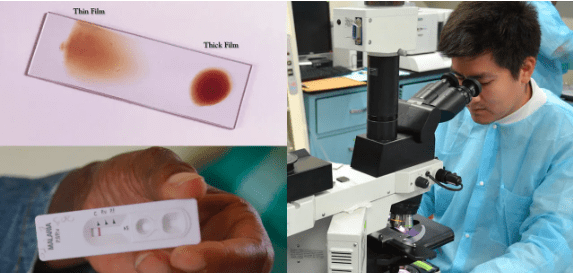Health
Differential Diagnosis of Malaria Fever

Differential Diagnosis of Malaria Fever
Malaria fever shares similarities with other febrile illnesses, making differential diagnosis crucial for effective management. Common conditions that may present with fever and resemble malaria include influenza, dengue fever, typhoid, and viral infections.
Diagnostic Tests for Malaria
Accurate and timely diagnosis is essential to distinguish malaria from other febrile illnesses. Various diagnostic tests are available, including rapid diagnostic tests (RDTs), microscopy, and molecular-based techniques like polymerase chain reaction (PCR).
Importance of Early Detection and Treatment
Early detection and prompt treatment of malaria fever are critical in preventing severe complications and reducing mortality rates. Timely intervention can also help prevent the spread of the disease to others.
Challenges in Malaria-Endemic Regions
In regions where malaria is endemic, access to healthcare facilities and diagnostic tools may be limited, leading to delays in diagnosis and treatment. Additionally, drug-resistant strains of the parasite pose significant challenges to effective treatment.
Integrating Community-Based Programs
To address these challenges, community-based programs play a vital role in increasing awareness, providing early diagnosis, and ensuring access to treatment and preventive measures.
The Global Effort to Combat Malaria
Malaria remains a major public health concern in many parts of the world. Various international organizations, governments, and non-governmental organizations (NGOs) are actively involved in the fight against malaria.
The Roll Back Malaria (RBM) Partnership
The RBM partnership, established in 1998, brings together multiple stakeholders to coordinate efforts and resources in the fight against malaria. It focuses on prevention, treatment, research, and advocacy.
The Impact of Malaria on Socioeconomic Development
Malaria has far-reaching effects on communities, impacting economic productivity, healthcare costs, and educational opportunities, particularly in regions with high transmission rates.
Innovative Strategies for Malaria Control
In recent years, innovative strategies have been employed to control and eliminate malaria. Some of these include genetically modified mosquitoes, targeted malaria elimination campaigns, and the use of drones for delivering healthcare supplies to remote areas.
The Road Ahead: Working Toward Malaria Eradication
The ultimate goal in the fight against malaria is global eradication. Eradicating malaria requires sustained efforts, research, and collaboration among countries and organizations worldwide.
Leveraging Technology for Surveillance
Advancements in technology play a crucial role in malaria surveillance and control. Mobile applications, data analytics, and artificial intelligence are used to track cases, monitor drug resistance, and predict outbreaks.
Climate Change and Its Impact on Malaria Transmission
The impact of climate change on malaria transmission is a growing concern. Changes in temperature and rainfall patterns can influence mosquito behavior and the geographic spread of the disease.
Engaging Local Communities for Sustainable Solutions
Engaging with local communities is essential for the success of malaria control programs. Empowering communities with knowledge, resources, and support can lead to sustainable solutions and behavior change.
FAQs:
Can malaria fever occur at irregular intervals?
A: While malaria fever typically follows a periodic pattern, some factors, such as mixed infections or drug resistance, may lead to irregular fever episodes.
Are all species of Plasmodium responsible for periodic malaria fever?
A: No, periodic malaria fever is predominantly associated with Plasmodium falciparum, the most deadly species, but it can also occur in other Plasmodium species.
Can malaria fever intervals vary among individuals?
A: Yes, the intervals between malaria fever episodes can vary based on factors like the strain of the parasite, the individual’s immune response, and previous exposure to malaria.
Is malaria fever the only symptom of the disease?
A: No, malaria can cause a range of symptoms, including chills, headache, muscle aches, and fatigue, in addition to fever.
How long do malaria fever episodes typically last?
A: Malaria fever episodes can last for a few hours to several days, depending on the severity of the infection.
Can malaria fever recur after successful treatment?
If not adequately treated, malaria fever can recur due to the persistence of dormant parasites in the liver.
Does the timing of malaria fever follow a specific pattern?
A: Yes, the timing of malaria fever often follows a cyclic pattern, with fever spikes occurring at similar times during each cycle.
Is malaria fever preventable through vaccination?
Currently, there is no licensed malaria vaccine available for widespread use, but ongoing research aims to develop an effective vaccine.
Are there specific groups at higher risk of severe malaria fever?
A: Yes, young children, pregnant women, and individuals with weakened immune systems are at higher risk of developing severe malaria.
Can malaria fever be mistaken for other febrile illnesses?
Yes, malaria fever shares similarities with other febrile illnesses, and accurate diagnosis is crucial for effective management.
Conclusion
Unraveling the mystery of malaria fever’s regular intervals has provided invaluable insights into the complex interactions between the parasite and its human host. By understanding the lifecycle of the malaria parasite,
the role of synchronized erythrocytic schizogony, and the influence of circadian rhythms, we have gained critical knowledge that can guide future research and the development of effective prevention and treatment strategies.
As we continue to make progress in malaria control and eradication efforts, it is crucial to emphasize early detection, prompt treatment, and community engagement.
Global collaborations, technological advancements, and sustainable interventions hold the key to combating this deadly disease and eventually achieving a world free of malaria.
Health
7 Fascinating Facts About Magnesium You Probably Didn’t Know

7 Fascinating Facts About Magnesium You Probably Didn’t Know
Magnesium is one of the most essential minerals for our health, yet many people are unaware of its significance.
This vital nutrient plays a crucial role in numerous bodily functions, from energy production to maintaining a healthy heart.
In this article, we will delve into seven intriguing facts about magnesium that may surprise you and help you appreciate its importance in your daily life.
What is Magnesium?
Magnesium is a naturally occurring mineral found in various foods and is vital for human health.
It is the fourth most abundant mineral in the body and is involved in over 300 biochemical reactions.
Magnesium contributes to nerve function, muscle contraction, blood sugar control, and blood pressure regulation.
It can be obtained from various dietary sources, including leafy greens, nuts, seeds, whole grains, and legumes.
1. Magnesium is Involved in Energy Production
Did you know that magnesium is essential for converting food into energy? This mineral plays a critical role in the activation of ATP (adenosine triphosphate), the energy currency of our cells.
Without sufficient magnesium, your body struggles to produce energy effectively, which can lead to feelings of fatigue and weakness.
How Does It Work?
ATP production occurs in the mitochondria, often referred to as the powerhouse of the cell.
Magnesium helps activate enzymes involved in this energy production process, ensuring that your body has enough energy to perform daily activities.
2. A Key Player in Bone Health
Magnesium is vital for maintaining strong and healthy bones. Approximately 60% of the magnesium in your body is stored in your bones.
It contributes to bone density and strength by regulating calcium levels in the body, which is crucial for bone formation.
The Calcium Connection
Calcium is often touted as the primary mineral for bone health, but magnesium plays an equally important role.
An imbalance of these two minerals can lead to bone-related issues such as osteoporosis.
Ensuring adequate magnesium intake is essential for maintaining optimal bone health.
3. Supports Heart Health
Magnesium is a crucial mineral for cardiovascular health. It helps maintain normal heart rhythms and can reduce the risk of heart disease.
Adequate magnesium levels are associated with lower blood pressure and reduced risk of heart attacks.
Regulation of Blood Pressure
Magnesium helps relax blood vessels, which can lead to lower blood pressure.
Studies have shown that individuals with higher magnesium intake tend to have better cardiovascular health. Including magnesium-rich foods in your diet can be an effective strategy for supporting heart health.
4. Magnesium and Mental Health
Emerging research suggests a strong link between magnesium levels and mental health.
Magnesium plays a role in regulating neurotransmitters, which are essential for mood stabilization.
Low magnesium levels have been associated with an increased risk of depression and anxiety.
Cognitive Function
Magnesium may also enhance cognitive function. Studies have indicated that adequate magnesium intake can improve memory and learning abilities.
This mineral is essential for brain health, making it vital for overall mental well-being.
5. Magnesium Deficiency is Common
Despite its importance, magnesium deficiency is surprisingly common.
Factors such as poor diet, chronic stress, and certain medical conditions can lead to low magnesium levels.
Symptoms of magnesium deficiency can include muscle cramps, fatigue, and irritability.
Risk Factors for Deficiency
Certain populations are at a higher risk for magnesium deficiency, including the elderly, those with gastrointestinal diseases, and individuals who consume a diet low in whole foods.
It’s essential to recognize the signs of deficiency and consider increasing your magnesium intake through diet or supplements if necessary.
6. Natural Relaxant
Magnesium is often referred to as a natural relaxant due to its calming effects on the nervous system.
It helps regulate cortisol levels (the stress hormone) and promotes relaxation, making it beneficial for those dealing with anxiety and stress.
Improving Sleep Quality
In addition to its relaxing properties, magnesium can improve sleep quality.
Many people find that magnesium supplements help them fall asleep faster and stay asleep longer, making it a popular choice for those struggling with insomnia.
7. Magnesium in Sports Performance
Athletes and active individuals often benefit from magnesium’s role in muscle function and recovery.
Magnesium helps prevent muscle cramps and can aid in post-exercise recovery by reducing inflammation and promoting relaxation.
Enhancing Athletic Performance
Research has shown that adequate magnesium levels can enhance athletic performance.
It is involved in muscle contraction and relaxation, making it essential for peak performance during exercise.
Conclusion
Magnesium is a powerhouse mineral that plays an essential role in various bodily functions. From supporting energy production to promoting heart health and mental well-being, its importance cannot be overstated.
Ensuring adequate magnesium intake through a balanced diet rich in whole foods can significantly enhance your overall health and quality of life.
If you suspect you may be deficient in magnesium, consider consulting with a healthcare provider to assess your levels and discuss dietary changes or supplements that may be beneficial.
FAQs about Magnesium
1. What are the best dietary sources of magnesium?
The best sources of magnesium include leafy green vegetables (like spinach), nuts (especially almonds and cashews), seeds (such as pumpkin seeds), whole grains (like brown rice and quinoa), and legumes (like beans and lentils).
2. How much magnesium do I need daily?
The recommended daily intake of magnesium varies by age and gender. Generally, adult men should aim for about 400-420 mg per day, while adult women should aim for about 310-320 mg.
3. Can I take magnesium supplements?
Yes, magnesium supplements are available and can be beneficial, especially for individuals who may not get enough from their diet. However, it’s essential to consult with a healthcare provider before starting any supplement regimen.
4. What are the symptoms of magnesium deficiency?
Symptoms of magnesium deficiency can include muscle cramps, fatigue, weakness, irritability, and irregular heart rhythms. If you experience these symptoms, consult a healthcare professional.
5. Is it possible to get too much magnesium?
Yes, while magnesium from food sources is generally safe, excessive supplementation can lead to toxicity, causing symptoms like diarrhea, nausea, and abdominal cramping. Always consult a healthcare provider before increasing your magnesium intake significantly.
References:
Health
Whooping Cough: Understanding Its Resurgence and Prevention

Health
The Power of Beans: Why This Superfood is a Nutritional Treasure
-

 Trending Stories1 year ago
Trending Stories1 year agoCDC: 1 in 4 Americans Still COVID-Free by End of 2022
-

 Health5 years ago
Health5 years agoMeghan Trainor Shares Motivational New Song ‘Blink’
-

 Health6 months ago
Health6 months agoHow Do Pawpaw Seeds Support Cardiovascular Health?
-

 Health2 years ago
Health2 years agoHow Long Does Monkey Pox Last Before It Surfaces in the Body?
-

 Health3 years ago
Health3 years agoWhat Causes Swollen Body? Understanding Edema and its Triggers
-

 Health3 years ago
Health3 years agoNutrition and the Importance of a Fitness Program – 3 Things to Know
-

 Health3 years ago
Health3 years ago5 Weird Reasons Why Pimples Disappear After Marriage
-

 Health2 years ago
Health2 years agoHealth Benefits Of Pawpaw Seed? 7 Things To Know






